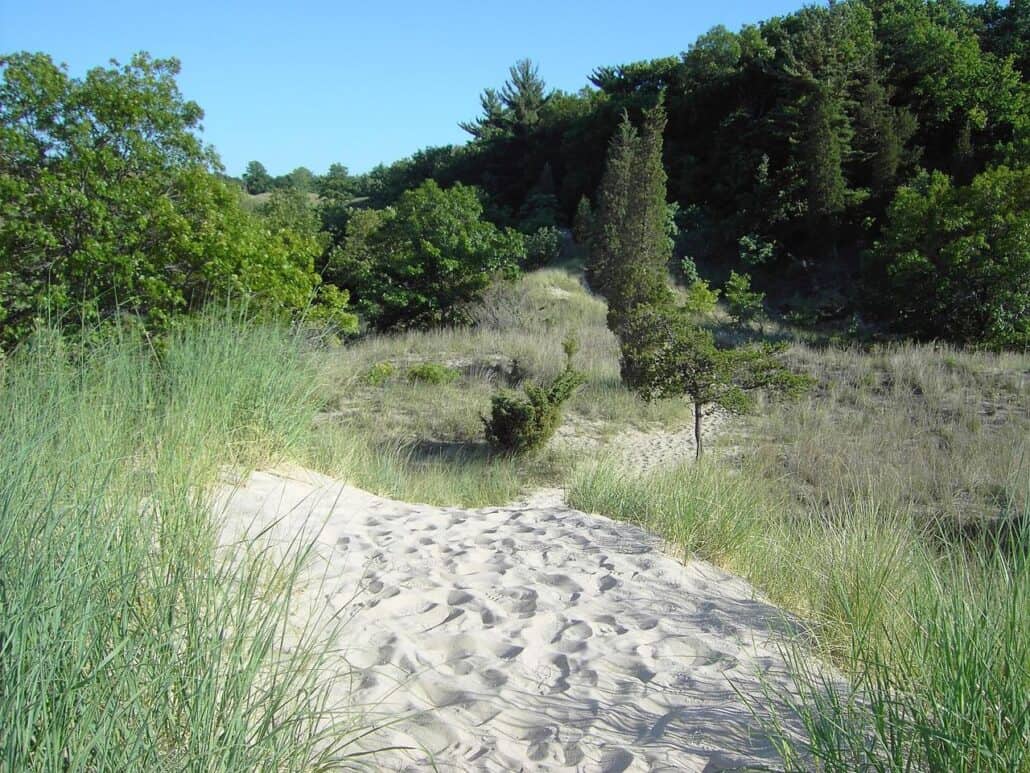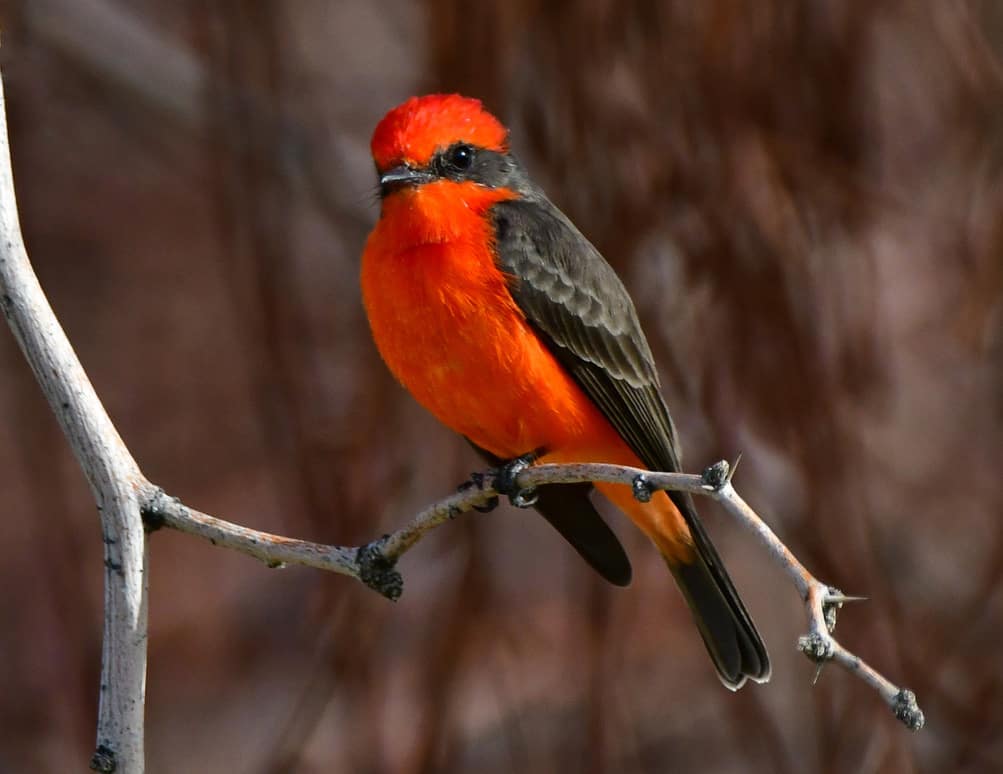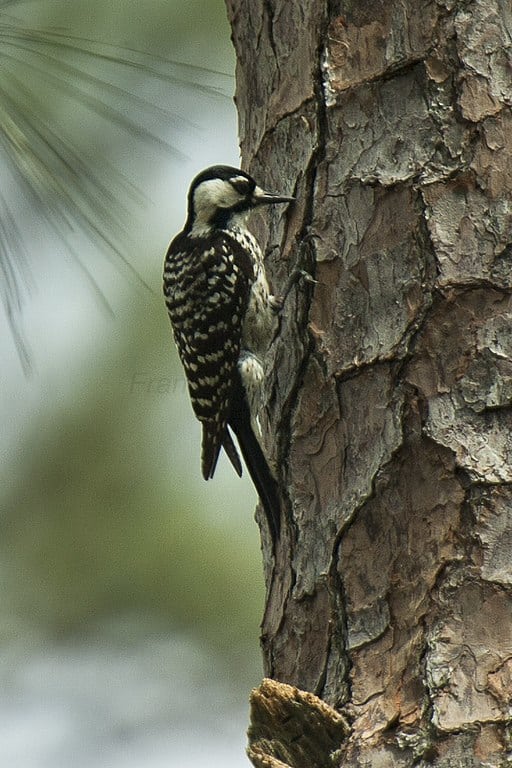Jasper-Pulaski State Fish and Wildlife Area
5822 N. Fish and Wildlife Lane, Medaryville, IN 47975
(219) 843-4841
The greatest birding spectacle in Indiana is the gatherings of sandhill cranes at Jasper-Pulaski, or J-P. This area of woodlands, fields, and shallow lakes is a staging area in spring and especially in fall for thousands of sandhill cranes. Bird watchers from Indiana and surrounding states make annual fall trips to J-P in late October or early November when they may see and hear 30,000 of these great gray birds gathering at dusk in a field before flying out to roost standing in the shallow water of the lakes. Now, with whooping cranes migrating from Wisconsin, south to the Chassohowitzka Refuge in Florida, there is an increasing chance of seeing one or more of these endangered birds with the sandhills at J-P. Observation platforms make long-distance viewing of the birds easier.
J-P is also a place of migrating waterfowl in spring and fall and some of the ducks of several species stay in spring to nest. There are marsh birds, too. At times in spring the woodland trees are alive with warblers. Then, too, there are vireos and flycatchers and thrushes to delight sharp-eyed bird watchers.
Indiana Dunes National Lakeshore area
1100 N. Mineral Springs Rd.
Porter, IN 46304
(219) 926-7561
Indiana Dunes State Park
1600 N. 25 E.
Chesterton, IN 46304
(219) 926-1952
This is a combination of the National Lakeshore, Indiana Dunes State Park, and tracts of private land along the shore of Lake Michigan from Gary to Michigan City. There is the shoreline and behind it the sand dunes including Big Baldy, a huge, active dune that is slowly moving south, burying an oak woodlot. There are bird-filled wetland woods, bogs, and areas of wetland prairie. The lakeshore and diversity of habitat attracts a variety of birds.
Many rarities for Indiana have been seen here including scoters, jaegers, glaucous, Iceland, little, and Sabine’s gulls, and black-legged kittiwake. Snowy owls, boreal chickadees, and hoary redpolls have been seen here. On a broad sandy beach in Michigan City and from a stone jetty and breakwater there, harlequin ducks, king eiders, and purple sandpipers have been spotted in winter. Fall is when the most rare birds have been spotted in this area but any time in fall, winter, or spring may turn up a rare bird.
Willow Slough State Fish and Wildlife Area
2042 South 500 W
Morocco, IN 47963
(219) 285-2704
This is an area of woodland, prairie, marsh, and lake, an area where once the forest gave way to prairie and marsh. Such variety of habitat attracts a variety of birds, of course. Waterfowl, gulls and terns, herons, rails, grassland birds, warblers, vireos, thrushes, flycatchers, swallows—Willow Slough gets them all. A number of rare species for Indiana have been seen at Willow Slough including Ross’s goose, black rail, yellow-headed blackbird, and Smith’s longspur, a tundra-nester from the Far North that passes through during spring and fall migration.
Osprey and bald eagle can be seen here and this is an excellent place to listen for owls at night. As a state fish and wildlife area, Willow Slough is managed for hunting, fishing, camping, and other outdoor activities. Call ahead to check on access—some areas are closed during the various hunting seasons.
Kankakee State Fish and Wildlife Area
4320 W. Toto Rd.
PO Box 77
North Judson, IN 46366
(574) 896-3522
Once this was part of the extensive Kankakee River Marsh, a natural wonder covering hundreds of thousands of acres in this region of Indiana. The concentrations of ducks, geese, and shorebirds are said to have “blackened the skies” before the area was settled. Much of the Kankakee was drained for agriculture in the late 1800s. What remains today—just a fraction of the original—is still excellent for bird watching.
The Yellow River flows into the Kankakee River here. There is riverbank woodland (good for warblers, vireos, tanagers, and orioles in spring and summer) wet marshy areas (good for rails and shorebirds) and low fields (sparrows and meadowlarks) that are flooded frequently. It’s a place to see waterfowl and shorebirds in spring. In fall, due to intensive waterfowl hunting around the property, it is closed to prevent ducks being flushed out to waiting hunters. Call ahead to determine access to the best birding areas.
Pigeon River State Fish and Wildlife Area
8310 East 300 N
Box 71
Mongo, IN 46771
(260) 367-2164
This is a long, narrow state wildlife area comprising 11,605 acres along 17 miles of the Pigeon River. It has farmland, scrubby pastureland, prairie plantings, wetlands, forest and impoundments for waterfowl resting areas. Always a place for large numbers of waterfowl in spring and fall, it is becoming a fall staging area for sandhill cranes with several hundred there in recent years. It is also a good place to see migrating shorebirds. Look for them along any exposed mudflats and along the edges of wetlands. Spring mornings can offer rewarding warbler watching in Pigeon River’s woodlands, especially along the river itself.
As with other Indiana State Fish and Wildlife Areas, Pigeon River is managed for hunting and fishing. During fall waterfowl-hunting season large areas are closed to non-hunters, so it is advisable to call ahead for information about seasonal access.
Salamonie Reservoir
9214 West-Lost Bridge West
Andrews, IN 46702
(260) 468-2125
This is a flood-control reservoir, the center one of three created by dams that hold water to prevent flooding on the upper reaches of the Wabash River. The reservoir varies from 976 acres in winter to 2,855 in summer with a maximum flood-holding capacity of 9,000 acres. The land around the reservoir is river bluffs, agricultural fields, former agricultural fields now growing up to brush and trees, planted prairie plots, and woodlots. Drawdown of the water creates vast mudflats in late fall and winter, so check these areas for shorebirds. In summer the lake is used heavily by boaters, so the birding opportunities are diminished. When the water level goes above the summer level, for flood control, there is flooding of fields and woods. There are smaller impoundments, ponds and marshes, around the reservoir.
The diversity of habitat and the annually fluctuating water level make this a place of waterbirds, shorebirds, woodland birds, and birds of open fields.
Big Oaks National Wildlife Refuge
1661 West JPG Niblo Road
Madison, IN 47250
From 1940 to 1995 this was a U.S. Army Base, the Jefferson Proving Grounds. Here shells and rockets and bombs were tested. The result is many areas of the property where there are unexploded shells and bombs. Since the cost of cleaning up those areas is prohibitive, the refuge has large areas that are unsafe and “off limits.” Visitors are permitted on the refuge only in safe areas, and only on Monday and Friday, April through November, and on the second and fourth Saturdays of those months. Each visitor is given a safety briefing and must sign a form acknowledging that he or she understands the restrictions and the reasons for them.
Big Oaks, in spite of the limitations and safety hazards, is worth a birder‚s time. It combines grasslands and woodlands that produce the highest nesting populations of Henslow’s sparrows and cerulean warblers in the state. Turkeys and deer are common in the woodlands and many other species frequent these habitats. There is a 165-acre lake that attracts good numbers of waterfowl in spring and summer.
Muscatatuck National Wildlife Refuge
12985 E. U.S. Highway 50
Seymour, IN 47274
This is river bottomland that was once hardwood forest. The forest was largely cleared for timber and the land converted to agriculture. But farming was difficult because of annual spring flooding and poor drainage that left the land wet long after the flood subsided. Now the land is managed through planting, controlled burning, and water-level manipulation to provide forest, wetland, and grassland habitat for birds and wildlife.
The Muscatatuck River flows through the refuge, fed by streams and natural springs, and there are natural and artificial, shallow impoundments. This habitat attracts many ducks, especially wood ducks, and Canada geese plus other waterbirds and wildlife. Summer tanager and blue grosbeak, generally more southern species uncommon in Indiana, have nested here. For several years there has been a resident pair of bald eagles.
Patoka River National Wildlife Refuge
510 W. Morton Box 217
Oakland City, IN 47660
(812) 749-3199
This is a growing property in southern Indiana, presently between 5,000 and 6,000 acres with a goal of becoming 22,000 acres as land becomes available and there is money for purchase. Like Muscatatuck, this is a river bottomland habitat and is managed extensively for waterfowl, particularly wood ducks. The overall management objective, more limited than at Muscatatuck, is primarily the restoration of the bottomland hardwood forests. However, the Cane Ridge Unit of the refuge has the largest nesting population of interior least terns east of the Mississippi River. Many bird watchers visit Patoka River NWR in early summer especially to see this federally endangered species.
Other birds to look for here include American woodcock, wild turkey, scarlet tanager, yellow warbler, common yellowthroat, Louisiana waterthrush, Carolina chickadee, and red-headed and pileated woodpecker. Spring and fall migration are the most active periods for birds, but summer and winter can be productive as well.
Hovey Lake State Fish and Wildlife Area
15010 SR 69 S
Mt. Vernon, IN 47620
(812) 838-2927
This is an oxbow lake of more than 4,000 acres along the Ohio River. Oxbows are created when a big, curving bend in large river is cut off, often when the river changes course during a powerful flood, taking a permanent shortcut, leaving behind an oxbow. Such is the case with Hovey Lake. The lake has many bald cypress tree growing where it is most shallow and around the shore in places.
The cypress and the expanse of water attract ducks, geese, double-crested cormorants, little blue and great blue herons, black-crowned and yellow-crowned night herons, and snowy egrets in summer and fall, though the egrets don’t nest there. Bald eagles do, however, and recently a pair of ospreys has nested here, too. In spring, fall, and winter there can be many waterfowl and in spring on those certain days that bird watchers dream about, the trees can be full of migrant warblers.




